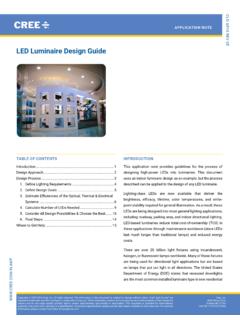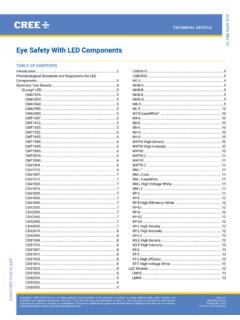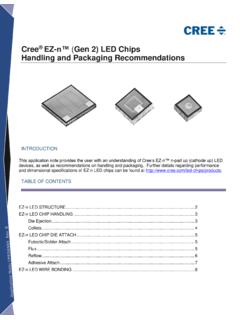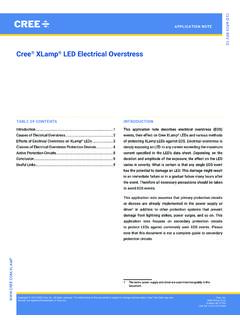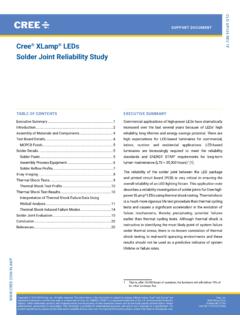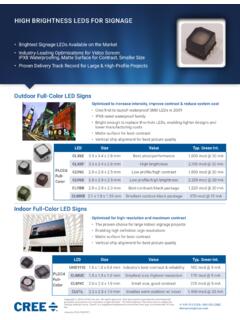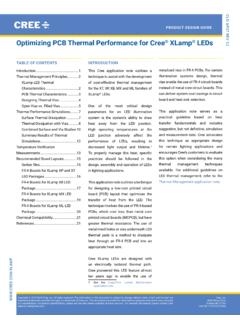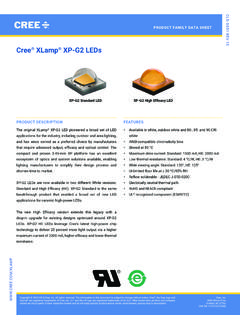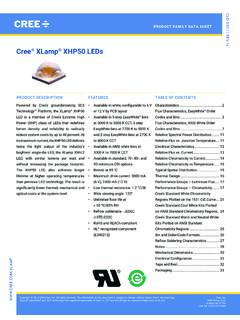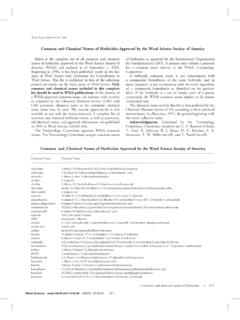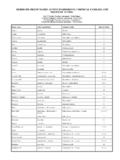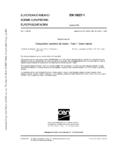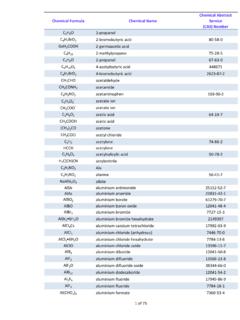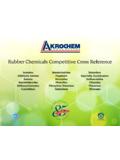Transcription of Cree XLamp LEDs
1 Support DocumentCopyright 2011-2018 Cree, Inc. All rights reserved. The information in this document is subject to change without notice. Cree and XLamp are registered trademarks and the Cree logo is a trademark of Cree, Inc. Other trademarks, product, and company names are the property of their respective owners and do not imply specific product and/or vendor endorsement, sponsorship or association. This document is provided for informational purposes only and is not a warranty or a specification.
2 For product specifications, please see the data sheets available at For warranty information, please contact Cree Sales at Silicon DriveDurham, NC 27703 USA Tel: + rev 6 JAnuAry, 2018 Cree XLamp LEDsChemical CompatibilityTabLE of ConTEnTsexecutive Summary ..1 Background and Introduction ..2examples of Chemical Incompatibility ..3reversibility of vOC-Based Discoloration ..6 Material Selection Considerations ..8 Chemical Compatibility Testing ..9 Chemical Compatibility Test Procedure ..11evaluation.
3 12 Provide Post-Test Information to Cree ..12 Chemical Compatibility Test Kit Availability ..13 Conclusion ..13 Helpful ..14 EXECuTivE summaryThe presence of incompatible volatile organic compounds (vOCs) in LeD-based solid-state lighting (SSL) designs can impair the performance and reduce the lifetime of these illumination systems. Glues, conformal coatings, O-rings, gaskets, and potting compounds are examples of materials frequently used in the construction of LeD-based luminaires or lamps and often contain vOCs.
4 The presence of chemically incompatible vOCs on or near LeDs can degrade the light output levels or cause changes in the chromaticity point of the light. The photograph in Figure 1 above is an example of this vOC degradation on the surface of an LeD. This sensitivity to vOCs is not unique to one LeD manufacturer but is a known problem for all types of blue, royal blue and white-light LeDs. Chemical incompatibility in SSL is often a localized phenomenon that occurs in luminaire designs that seal portions of the system, resulting in an LeD operating environment having elevated temperatures with little or no air movement.
5 However, with proper design and adequate testing, chemical incompatibility effects can be maintains lists of chemicals known to be incompatible with XLamp LeDs and has partnered with materials manufacturers to inform our customers with information on acceptable materials. These lists are in the Appendix at the end of this document. Customer testing is a good way to further develop an understanding of chemical incompatibilities of a new LeD figure 1: XLamp LED discolored as a result of exposure to incompatible chemicalsCopyright 2011-2018 Cree, Inc.
6 All rights reserved. The information in this document is subject to change without notice. Cree and XLamp are registered trademarks and the Cree logo is a trademark of Cree, Inc. Other trademarks, product, and company names are the property of their respective owners and do not imply specific product and/or vendor endorsement, sponsorship or association. This document is provided for informational purposes only and is not a warranty or a specification. For product specifications, please see the data sheets available at For warranty information, please contact Cree Sales at LeD CHeMICAL COMPATIBILIT ylighting design.
7 With proper material selection design and testing, chemical incompatibility effects can be minimized or removed from SSL anD inTroDuCTionMost SSL luminaire types are implemented with a blue light LeD chip covered with a yellow phosphor and silicone encapsulant to convert the blue light to a broader white light spectrum. This entire LeD assembly is covered by a silicone-based lens. Figure 2 is a cross-section drawing of a typical lighting-class LeD. figure 2: Cross-sectional structure of a typical lighting-class LEDThe unique silicone polymers utilized in LeDs have excellent light transmittance characteristics: stable over wide temperature ranges, resistant to yellowing due to ultraviolet (uv) exposure and easily molded.
8 This results in a high-performance yet cost-effective LeD. The basic structure of the LeD s lens and encapsulants is a silicone polymer, which is a stable chemical vOCs present in an SSL system can diffuse into the gas-permeable silicone lens and encapsulants of the LeD. Within the molecular structure of these silicone materials, the vOCs will occupy a free space in the interwoven silicone polymer. With subsequent exposure to high photon energy emitted from the LeD, along with the heat from the lighting system and the environment, the volatile compounds trapped in the LeD s lens or encapsulants can discolor.
9 This discoloration of the trapped vOCs can degrade the light emitted from the LeD. This discoloration tends to occur in blue, royal blue and white-light producing LeDs that use blue wavelength LeD chips with yellow phosphors for spectrum conversion. This sensitivity to vOCs is not unique to one LeD manufacturer but is a known problem for all types of blue, royal blue and white-light LeDs. Chemically induced discoloration is less prevalent and not as noticeable with amber, red and green LeDs; these color LeDs have longer wavelengths and therefore a lower frequency and produce lower photonic energy compared to blue LEDs.
10 Photonic energy (E) is defined by the Planck-Einstein equation of E = hf, where h is Planck s constant and f is frequency, thus a higher frequency produces a higher photonic application note presents: real-world examples of discoloration caused by vOCs Sources of chemical incompatibility from the general classes of materials used in SSL systems Discussion and examples of the reversibility of discoloration from vOCs Cree s recommended best practices to maintain chemical compatibility Anode Cathode Blue LED ChipCovered by Phosphors& Silicone Encapsulant Silicone Lens Substrate Tsp Copyright 2011-2018 Cree, Inc.

